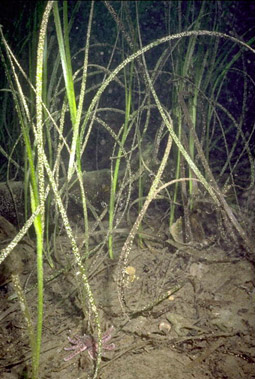Zostera
| Zostera (marine eelgrasses) | |
|---|---|

| |
| Zostera marina | |
| Scientific classification | |
| Kingdom: | Plantae |
| Clade: | Angiosperms |
| Clade: | Monocots |
| Order: | Alismatales |
| Family: | Zosteraceae |
| Genus: | Zostera L. |

| |
| Global distribution map of Zostera. Green indicates presence. | |
| Synonyms[1] | |
| |

Zostera is a small genus of widely distributed seagrasses, commonly called marine eelgrass or simply eelgrass. The genus Zostera contains 15 species.
Ecology
Zostera marina is found on sandy substrates or in estuaries, usually submerged or partially floating. Most Zostera are perennial. They have long, bright green, ribbon-like leaves, the width of which are about 1 centimetre (0.4 in). Short stems grow up from extensive, white branching rhizomes. The flowers are enclosed in the sheaths of the leaf bases; the fruits are bladdery and can float.
Zostera beds are important for sediment deposition, substrate stabilization, as substrate for epiphytic algae and micro-invertebrates, and as nursery grounds for many species of economically important fish and shellfish. Zostera often forms beds in bay mud in the estuarine setting. It is an important food for brant geese and wigeons, and even (occasionally) caterpillars of the grass moth Dolicharthria punctalis.
The slime mold Labyrinthula zosterae can cause the wasting disease of Zostera, with Z. marina being particularly susceptible, causing a decrease in the populations of the fauna that depend on Zostera.
Zostera is able to maintain its turgor at a constant pressure in response to fluctuations in environmental osmolarity. It achieves this by losing solutes as the tide goes out and gaining solutes as the tide comes in.
Distribution
The genus as a whole is widespread throughout seashores of much of the Northern Hemisphere as well as Australia, New Zealand, Southeast Asia and southern Africa. The discovery of Z. chilensis in 2005 adds an isolated population on the Pacific coast of South America to the distribution. One species (Z. noltii) occurs along the land-locked Caspian Sea.
Uses
Eelgrass has been used for food by the Seri tribe of Native Americans on the coast of Sonora, Mexico. The rhizomes and leaf-bases of eelgrass were eaten fresh or dried into cakes for winter food. It was also used for smoking deer meat. The Seri language has many words related to eelgrass and eelgrass-harvesting. The month of April is called xnoois ihaat iizax, literally "the month when the eelgrass seed is mature".[2]
Zostera has also been used as packing material and as stuffing for mattresses and cushions.
On the Danish island of Læsø it has been used for thatching roofs. Roofs of eelgrass are said to be heavy, but also much longer-lasting and easier to thatch and maintain than roofs done with more conventional thatching material.
Zostera can also be utilized to produce biomass energy using the Jean Pain method.
Species
- Accepted species[1]
- Zostera angustifolia (Hornem.) Rchb. – Russian Far East, British Isles, Denmark, Sweden
- Zostera asiatica Miki – Russian Far East, Japan, Korea, NE China
- Zostera caespitosa Miki – Russian Far East, Japan, Korea, NE China
- Zostera capensis Setchell – Madagascar; Kenya to Cape Province
- Zostera capricorni Ascherson – New Guinea, Australia, New Zealand
- Zostera caulescens Miki – Russian Far East, Japan, Korea, NE China
- Zostera chilensis (J. Kuo) S. W. L. Jacobs & D. H. Les – Chile
- Zostera japonica Ascherson & Graebner – Russian Far East, Japan, Korea, China, Vietnam
- Zostera marina L. – shores of North Pacific, North Atlantic, British Isles Mediterranean, Black Sea, Sea of Okhotsk
- Zostera mucronata den Hartog – Australia
- Zostera muelleri Irmisch ex Ascherson – Australia
- Zostera nigricaulis (J.Kuo) S.W.L.Jacobs & D.H.Les – Australia
- Zostera noltii Hornem. – shores of Northeastern Atlantic, Mediterranean, Black Sea, Caspian Sea
- Zostera novazelandica Setchell – New Zealand
- Zostera polychlamys (J.Kuo) S.W.L.Jacobs & D.H.Les – Australia
- Zostera tasmanica Martens ex Ascherson – Australia
References
- ↑ 1.0 1.1 "World Checklist of Selected Plant Families: Royal Botanic Gardens, Kew". apps.kew.org. Retrieved 2017-02-02.
- ↑ Felger, Richard; Moser, Mary B. (1985). People of the Desert and Sea: Ethnobotany of the Seri Indians. Tucson: University of Arizona Press.
External links
| Wikispecies has information related to Zostera |
| Wikimedia Commons has media related to Zostera. |
- Flora Europaea: Zostera
- Flora of North America: Zostera
- Flora of China: Zostera species list
- Wasting disease of Zostera
- Historical Changes of Eelgrass in Buzzards Bay, MA (USA)
- Long Island's Seagrass conservation website, Seagrass.LI
Lua error in Module:Taxonbar at line 144: attempt to index field 'wikibase' (a nil value).
- Pages with script errors
- Commons category link is defined as the pagename
- Commons category link is on Wikidata using P373
- Zostera
- Alismatales genera
- Biota of the Atlantic Ocean
- Biota of the Pacific Ocean
- Biota of the Indian Ocean
- Biota of the Caspian Sea
- Salt marsh plants
- Flora of Europe
- Flora of Asia
- Flora of Africa
- Flora of the United States
- Flora of Canada
- Flora of Australia
- Flora of New Zealand
- Flora of Chile